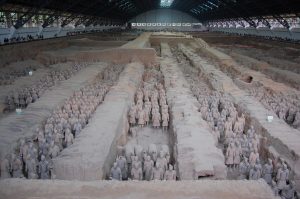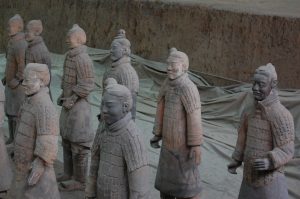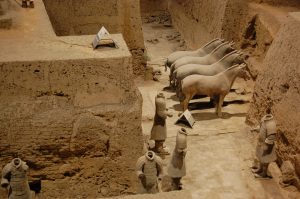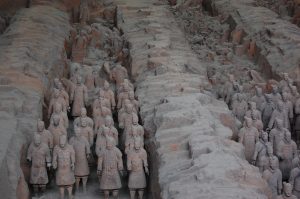Soon after his ascension to the throne of the Qin kingdom after his father´s death, Qin Shi Huang, then 13 years of age, ordered the construction of his Mausoleum and probably later as the first emperor of China, he conquered all other six warring states and unified all of China in 221 BC, the Terracotta army outside Xi´an.
700.000 men were sent there from all over the chinese empire. Double the amount of work force for the construction of the chinese Great Wall. It took over 38 years, from 246 to 208 BCE, to finish.

Bing Ma Yong = soldiers and horses statues
Yang Zhifa, then 41 years old, a peasant living in Xiyang, a village of the Lintong County 35 km east of Xi’an, decided on 23 March 1974 to dig a well in the middle of a draught with his five brothers, Yang Wenhai, Yang Yanxin, Yang Quanyi, Yang Peiyan, Yang Xinam, and another man, Wang Puzhi, to water their crops. They chose a little wood south of their village.

Red arrow: initial site of the intended well
At the depth of around 2m Zhifa noticed terracotta fragments, bronze arrowheads and terracotta bricks. The villagers sold the discoveries to the district cultural centre. In May 1974 a team of archaeologists came to the site and undertook the first excavations.
The site of the mausoleum was well known to historians long beforehand. Only the Terracotta army, Bing Ma Yong as called by the locals, was found totally by chance. It was not mentioned in any available sources up to this date.
The sites were kept secret to prevent looting. After completion all the work men involved were killed by imperial order or buried alive. There are estimatedly 8.000 soldier sculptures, 130 chariots, 520 horses and 150 cavalry horses. There are also numerous non-military figures besides.

In spite of mass production each face has an individual Expression
Only a quarter of the whole necropolis complex is uncoverd up to date. Like any other rulers of his time Qin Shi Huang intended obviously to take his royal household and guards along into the next life. It reflects a strong belief in a life after death which is still deeply rooted in chinese custom and habit until present time.

Researchers found out that the statues were originally colored
How to get to Bing Ma Yong from Xi´an City? From the bus terminal east of Xi´an railway station you can take the tourist bus no. 5 which drops you off at the Museum after an hour drive. It is posher, bigger and probably more expensive but long waiting queue and less frequent. Between the Terracotta army site and the Mausoleum there is a shuttlebus free of charge in front of the entrances.

The findings in fragments which are identified and assembled skilfully together by archaeologists
Few metres further from bus no. 5 bus no. 915 goes to Lintong railway station for 10 Yuan and from there few minutes drive with another bus to Bing Ma Yong. All well signposted. Last bus for the return journey departs at 7 pm.





